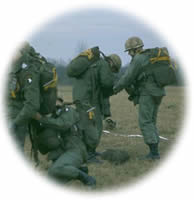
Grades 9-12

Don't have an account yet? Sign up for free
Don't have an account yet? Sign up for free

Perhaps you have seen the catchy TV ads for the various branches of the United States military. You know, the ones that tell you to “be all you can be…in the Army!.” In the last decade, these advertisements have become necessary because compulsory military service (otherwise known as “the draft”) no longer exists in the United States. Compulsory service, long required during time of war, was reinstituted in the United States in 1940, as the United States was on the brink of World War II. The draft remained in effect through the turbulent 1960s but was suspended by President Nixon in 1973. In the late 1970s, Congress passed legislation officially halting the draft.
 Perhaps you have seen the catchy TV ads for the various branches of the United States military. You know, the ones that tell you to “be all you can be…in the Army!” (Note: Teachers may wish to use the https://www.goarmy.com/ to introduce this lesson to your class). In the last decade, these advertisements have become necessary because compulsory military service (otherwise known as “the draft”) no longer exists in the United States. Compulsory service, long required during time of war, was reinstituted in the United States in 1940, as the United States was on the brink of World War II. The draft remained in effect through the turbulent 1960s but was suspended by President Nixon in 1973. In the late 1970s, Congress passed legislation officially halting the draft.
Perhaps you have seen the catchy TV ads for the various branches of the United States military. You know, the ones that tell you to “be all you can be…in the Army!” (Note: Teachers may wish to use the https://www.goarmy.com/ to introduce this lesson to your class). In the last decade, these advertisements have become necessary because compulsory military service (otherwise known as “the draft”) no longer exists in the United States. Compulsory service, long required during time of war, was reinstituted in the United States in 1940, as the United States was on the brink of World War II. The draft remained in effect through the turbulent 1960s but was suspended by President Nixon in 1973. In the late 1970s, Congress passed legislation officially halting the draft.
https://tcf.org/content/commentary/legions-stretched-thin-the-u-s-armys-manpower-crisis/
How has the elimination of compulsory service affected the number of military personnel that currently serve in the United States armed forces? What would you predict happened to the size of the military once the draft was eliminated? [answers may vary, but students’ initial reaction might be that they expect a smaller military with no compulsory service.] Economists often compare certain economic indicators from one year to the indicators (e.g., gross domestic product, consumer price index) from another year in order to determine the percentage change from one year to the next. In order to test your predictions, you must calculate the percentage change in the size of the military from one year to the next. The formula for calculating percentage change in military strength is:
Percentage change = (military strength Year 2 – military strength Year 1) / military strength Year 1
First, visit the Department of Defense’s personnel statistics, “Legions Stretched Thin .”
Next print out this worksheet. Use the formula above and the military strength numbers to complete the worksheet and then use this handy calculator to check your answers. You should be able to answer the following questions:
As we might have expected, more young men and women were in the military service in 1980 (at the end of the draft) than were serving in 1999 (nearly 20 years after the end of compulsory service). However, the greatest percentage decrease in service personnel took place from 1990 to 1995, more than 10 years after the end of the compulsory service requirement. It looks as if some other factors may account for the dramatic drop-off in the number of military personnel in service. What might some of these factors be? [Budget cuts, low pay, military no longer seen as an attractive career, post-Viet Nam attitude changes, post-Desert Storm cutbacks.]
Robert Schlesinger has an economic explanation for this mystery in his article “http://archive.boston.com/news/nation/washington/articles/2003/11/23/army_reserve_battling_an_exodus/ .” What does Schlesinger say are the main causes of this mass exodus of military personnel? [ (a) Tight labor markets–U.S. prosperity means that most everyone has a job, and low-paying industries like fast food restaurants are forced to pay more than minimum wage to attract workers; (b) lack of prestige to military service; (c) mostly due to low wages relative to other, less dangerous occupations, the base pay of a private in the U.S. Army is about the same as starting wages at fast food restaurants.]
 Let’s test Schlesinger’s theory by comparing the base salary of a private in the U.S. Army with what the same person might make earning the minimum wage in the civilian world. Currently the minimum wage in the United States is $5.15/hour. If our civilian worker is working 40 hours per week over 50 weeks then how much would he or she earn in a year? [$5.15/hr. X 40 hrs./week X 50 weeks = $10,300]
Let’s test Schlesinger’s theory by comparing the base salary of a private in the U.S. Army with what the same person might make earning the minimum wage in the civilian world. Currently the minimum wage in the United States is $5.15/hour. If our civilian worker is working 40 hours per week over 50 weeks then how much would he or she earn in a year? [$5.15/hr. X 40 hrs./week X 50 weeks = $10,300]
What does a private earn per year? Check out the military monthly base pay table, Basic Military Pay . Assume that our private (rank rating of E-1) has less than two years experience. What is her annual salary? [$12,060]
Using a 2000 hour work year (as we did above), what is her hourly wage? [$6.03] So the private, who is risking her life for her country, is making $.88 an hour more than the civilian burger flipper!
In order to compete, the Army (and the other branches of service) must use other, non-salary incentives to attract personnel. What might some of these incentives be? [College tuition, enlistment bonuses, housing and food allowances.] Log on to the https://www.goarmy.com/ to find several examples of these incentives.
Let’s look at how one of these incentives, the housing allowance, contributes to our private’s income. Using the https://www.thebalancecareers.com/basic-housing-allowance-bah-rates-3356707 , chose your private’s rank and state. What is the monthly housing allowance? [Answers will vary depending on location, but should be in the range of $425/month for a single soldier, $550/month for a soldier with dependents.] Adding this monthly allowance to the private’s salary means an annual income of how much? [Approximately $17,160 for the single soldier; $18,660 for the solider with dependents.] With this additional income, our private is now clearly making more than the minimum wage worker, but is it enough to get by? To learn more about the financial strain some military families experience read http://www.washingtonpost.com/wp-srv/local/daily/july99/military20.htm?noredirect=on .
Is it possible that, even with housing and food allowances, many U.S. soldiers and sailors are–as the previous article implies– living in poverty? If our private were the only breadwinner for her family of four (herself and three dependents), what is the US Census Bureau’s Poverty Threshold ? [$16,954] Is our private ‘living in poverty’? [Clearly no, but she’s not too far removed…her income is only $1,700 above the poverty threshold for a family of four with three dependents and she’s risking her life for her country…!]
Two basic tenets of economic behavior are that every decision has a cost (https://www.councilforeconed.org/wp-content/uploads/2012/03/voluntary-national-content-standards-2010.pdf ) and that people respond to incentives (https://www.councilforeconed.org/wp-content/uploads/2012/03/voluntary-national-content-standards-2010.pdf ). If U.S. citizens chose to join the military, they ‘trade-off’ the possibility of other (perhaps more lucrative) forms of employment. If the choice is between a potentially dangerous career in the military, then, or a safer, more stable civilian career where the pay is better, rational people will choose the latter. It would seem that Congress, the president and the nation’s military leadership have recognized these issues (as well as the severity of this most recent labor shortage), as recent legislation has been passed that gives military personnel the largest pay raise (4.8%) since 1981. Perhaps those who are trying to “Be All They Can Be” can do so on a bit more than minimum wage. The article Military Pay Raise Gap does a nice job of exemplifying this dilemma.

Grades 9-12

Grades 9-12

Grades 9-12

Content Partner
Grades 3-5
